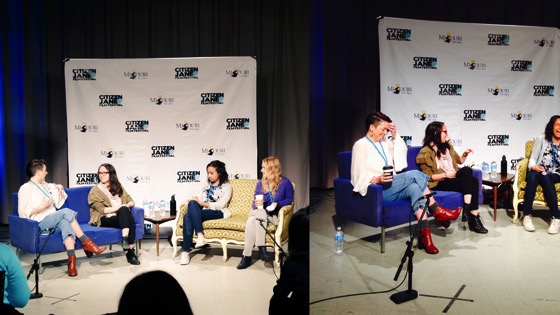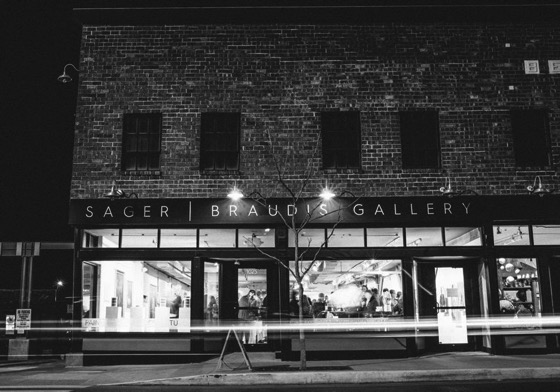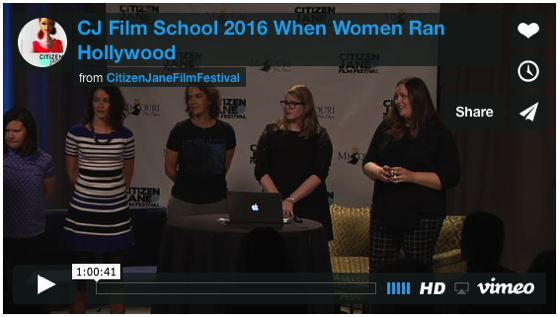Category: Writers on Writing
Stephens College MFA in Screenwriting representing at Citizen Jane Film Festival via Instagram
Badges! Badges! Get Your Badges! Stephens College’s Citizen Jane Film Festival via Instagram
Stephens College’s Citizen Jane Film Festival #cjff2017 #stephenscollege via Instagram
Setting up the Studio for pitch sessions, game show and papers from Stephens MFA students on early female Screenwriters. via Instagram
Setting up the Studio for pitch sessions, game show and papers from Stephens MFA students on early female Screenwriters. via Instagram
Good Morning, Columbia, MO via Instagram
A chilly start today to Stephens College’s Citizen Jane Film Festival. 40° This morning. CJ Film School all day today including presentations by Stephens College MFA in Screenwriting Students!
#cjff2017 #stephenscollege #movies #film #education via Instagram
Reading scripts on our flight from LA. Work. Work. Work. via Instagram
A History of Screenwriting – 41 in a series – The Wind – Frances Marion
A History of Screenwriting – 41 in a series – The Wind – Frances Marion
The Wind 1928 – 2015 Helictite live from resounding silents on Vimeo.
The Wind is a 1928 American silent romantic drama film directed by Victor Sjöström. The movie was adapted by Frances Marion from the novel of the same name written by Dorothy Scarborough. It features Lillian Gish, Lars Hanson and Montagu Love. It was one of the last silent films released by Metro-Goldwyn-Mayer, and is considered one of the greatest silent films.[1][2]
Gish came up with the idea of making a film adaptation of the novel of the same name. Irving Thalberg immediately gave her permission to do so. Gish recalled wanting Lars Hanson as her leading man after seeing him in a Swedish film with Greta Garbo. She also assigned Victor Sjöström as the director herself. Sjöström directed Gish before in the 1926 film The Scarlet Letter.[3]
The film was shot partially near Bakersfield and the Mojave Desert, California.[4]
In the original novel, the heroine is driven mad when the wind uncovers the corpse of the man she has killed. She then wanders off into a windstorm to die. According to Gish and popular legend, the original ending intended for the film was the unhappy ending, but it was changed due to the studio’s powerful Eastern office decreeing that a more upbeat ending be shot.[5] It is rumored that this tampering caused Seastrom to move back to Sweden. Mayer’s biographer rejects this on account that the “sad ending” is not known to exist in any form, written or filmed. Regardless of whether an unhappy ending was originally intended, in the resulting film the “happy” ending replaced the original ending against the wishes of both Lillian Gish and Victor Seastrom.[6] — Wikipedia
* A portion of each sale from Amazon.com directly supports our blogs *
* Many of these books may be available from your local library. Check it out!
I teach several classes for the Stephens College Low-Residency MFA in Screenwriting, including History of Screenwriting. In fact, I created the curriculum for that course from scratch and customized it to this particular MFA in that it covers ‘Screenwriting’ (not directors) and even more specifically, the class has a female-centric focus. As part History of Screenwriting I, the first course in the four-class series, we focus on the early women screenwriters of the silent film era who male historians have, for the most part, quietly forgotten in their books. In this series, I share with you some of the screenwriters and films that should be part of any screenwriters education. I believe that in order to become a great screenwriter, you need to understand the deep history of screenwriting and the amazing people who created the career. — Dr. Rosanne Welch
Join me at the Stephens College’s Citizen Jane Film Festival – Oct 26-29, 2017
Stephens College’s Citizen Jane Film Festival is fast approaching and the Stephens College MFA in Screenwriting will be out in force. Current MFA students will be presenting papers at the Festival, Stephens College will be sponsoring a production of a 5-minute film and hosting a live reading of the winner’s screenplay.
My husband, Douglas E. Welch, will be covering the event for me and the Festival, so watch my Twitter, Instagram and Facebook feeds for up-to-date information, photos and more.
Here are some of our big events:

Citizen Jane Film School
An afternoon of educational- and fun!- film industry discussions!
Studio A @ Stephens College, 1405 E Broadway
11:00 AM
Screen Grab: From Screenplay To Big Screen, Who Will Win?
Judges: Sarah Haas, Ken LaZebnik, Steph Scupham, Kimberly Skyrme
Screenwriters vie for an exclusive production deal pitching their films to a panel of esteemed judges. The top five entries will be discussed and critiqued live before the audience. The winner will be announced before panel’s end. Producer, Sarah Haas, awaits to bring the project to life-a screenwriter’s dream come true!
3:30 PM
Bold Brash Words From Bold Brash Screenwriters
Moderator: Dr. Rosanne Welch
Panelist: Amy Banks, Krista Dyson, Cara Epstein, Betsy Leighton, Laura Kirk, Sarah Whorton
The Stephens College MFA in Screenwriting Program is proud to present six of our fabulous students who will introduce the audience to six female screenwriters whose bold, brash, brilliant words have enhanced our film experience, but whose names have been left out of the textbooks. Help us write them back in and remind us all that Women Ran Hollywood once and are on their way to doing it again!

REHERSED: A CJ TABLE READ WITH GREENHOUSE THEATER PROJECT
Sager Braudis Gallery, 1025 E. Walnut
Sun / Oct 29 / 1:00 PM-3:00 PM
A staged reading of this year’s Screen Grab competition winner. Experience the art of Sager-Braudis Gallery, and watch as one of Columbia’s favorite theater companies reads a short screenplay. Refreshments provided by Harold’s Doughnuts and Fretboard Coffee.
A History of Screenwriting – 40 in a series – The Son of the Sheik – Frances Marion
A History of Screenwriting – 40 in a series – The Son of the Sheik – Frances Marion
The Son of the Sheik is a 1926 American silent adventure/drama film directed by George Fitzmaurice and starring Rudolph Valentino and Vilma Bánky. The film is based on the 1925 romance novel of the same name by Edith Maude Hull, and is a sequel to the 1921 hit film The Sheik, which also stars Rudolph Valentino.[2] The Son of the Sheik is Valentino’s final film and was released nearly two weeks after his death from peritonitis at the age of 31.
In 2003, the film was selected for preservation in the United States National Film Registry by the Library of Congress as being “culturally, historically, or aesthetically significant”.[3]
At the time of the film’s release, Rudolph Valentino was attempting to make a comeback in films.[4] He rose to international stardom after the release of The Four Horsemen of the Apocalypse and The Sheik in 1921, both of which were box office hits and solidified his image as “the Great Lover”.[5] By 1924, however, Valentino’s popularity had begun to wane after he appeared in two box office failures, Monsieur Beaucaire and A Sainted Devil, both of which featured him in roles that were a departure from his “Great Lover” image. He also squabbled over money with Famous Players-Lasky, the studio he was signed to, which eventually led to him walking out on his contract. Famous Players-Lasky eventually released Valentino from his contract and he signed with United Artists in 1925.[4] In an effort to capitalize on the success that Valentino had achieved with The Sheik, United Artists’ president Joseph M. Schenck bought the rights to Edith Maude Hull‘s novel Son of the Sheik and cast Valentino in the dual role of father and son.[2][6]
The novel was adapted for the screen by Frances Marion and Fred de Gresac.[2] The film was shot on location in California and in the Yuma Desert in Arizona.[7] — Wikipedia
* A portion of each sale from Amazon.com directly supports our blogs *
* Many of these books may be available from your local library. Check it out!
I teach several classes for the Stephens College Low-Residency MFA in Screenwriting, including History of Screenwriting. In fact, I created the curriculum for that course from scratch and customized it to this particular MFA in that it covers ‘Screenwriting’ (not directors) and even more specifically, the class has a female-centric focus. As part History of Screenwriting I, the first course in the four-class series, we focus on the early women screenwriters of the silent film era who male historians have, for the most part, quietly forgotten in their books. In this series, I share with you some of the screenwriters and films that should be part of any screenwriters education. I believe that in order to become a great screenwriter, you need to understand the deep history of screenwriting and the amazing people who created the career. — Dr. Rosanne Welch











